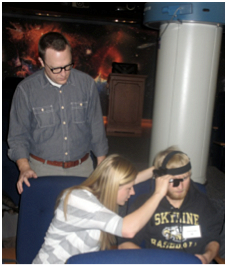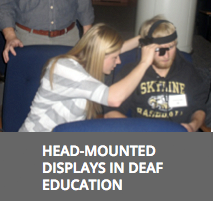Based on a submission by Michael Jones about his NSF-funded project to use augmented reality to improve learning by deaf children.

With a head-mounted display, deaf children can see sign language even when their head is turned away from the signer, allowing them to “hear” explanations and see scientific phenomena at the same time. Head-mounted displays (HMDs) are small computer screens attached to a glasses frame and worn next to the eye. Researchers at Brigham Young University and Gallaudet University have worked with deaf children to learn how to make HMDs comfortable and useful for deaf children. Researchers studied the fit and balance of the display and also the size and position of the signer within the display. The signer shown in the display should be sized to match the relative real-world size relationship of the signer and the phenomena and the signer should be placed near the center of the student’s field of view.
NSF Award Information
Title: EXP: Exploring augmented reality to improve learning by deaf children in planetariums.
Award Details
PIs: Michael Jones, Fred Mangrubang, Eric Hintz, Ron Proctor
A person watching sign language can either watch the signer and see what is being said or watch some phenomenon and see what is being talked about—but not both. This makes it difficult for deaf learners to focus their attention on both an explanation and a phenomenon at the same time. Watching sign language in an HMD moves the signer with the person’s head and allows a person to switch between signer and phenomenon with less effort. This work was done in the context of planataria, and deaf learners were part of the research team. Results are expected to be applicable in other formal and informal learning settings.
We know that people can pay close attention to only one thing at a time. Understanding how people switch attention effectively among multiple inputs helped us understand ways that HMDs could be used by deaf children to more easily switch their attention between a signer and some phenomenon of interest or importance. For full transfer to other aspects of deaf education it is important now to direct our attention to other learning scenarios such as reading a book at home, dissecting an owl pellet in class, or taking a field trip outside.
Image credit: Michael Jones, Brigham Young University

